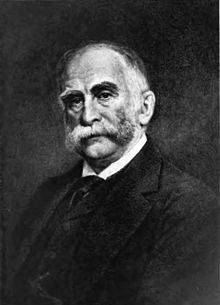James C. Carter
James C. Carter | |
|---|---|
 After an etching on copper plate by James S. King, copyrighted and published by Charles Barmore of New York. | |
| Born | October 14, 1827 Lancaster, Massachusetts, U.S. |
| Died | February 14, 1905 (aged 77) |
| Nationality | American |
| Alma mater | Harvard College, 1850 Harvard Law School, 1853 |
| Occupation | Lawyer |
James Coolidge Carter (1827–1905) was a New York City lawyer, a partner in the firm that eventually became Carter Ledyard & Milburn, which he helped found in 1854.
Carter graduated from Harvard College in 1850 and Harvard Law School in 1853.[1]
He was one of the founders and the first president of the National Civic League.
In 1892, he was appointed one of the counsel to present the claims of the United States before the Bering Sea tribunal.[2][3]
He died in New York City on February 14, 1905.[4][5][6][7][8][9][10]
Political Mugwump
Carter was an influential legal theorist among fellow Mugwumps. He deeply distrusted politicians and most elected officials. Instead he put his trust in disinterested experts, especially judges. He equated common law with custom, and his condemnation of legislation inconsistent with custom, reflected his Mugwumpism. He tried to synthesize traditional thinking with modernity. For example, Carter clung to support for active government intervention he learned from the antebellum Whigs, but he more and more embrace antigovernment positions typical of antebellum Jacksonians. He tried to synthesize traditional faith in timeless, objective moral principles with a more modern vision of evolving customary norms. Given growing problems of industrial urban society he saw the need for positive government but wanted judges to rule not politicians.[11]
References
- ^ Wilson, J. G.; Fiske, J., eds. (1900). . Appletons' Cyclopædia of American Biography. New York: D. Appleton.
- ^ Gilman, D. C.; Peck, H. T.; Colby, F. M., eds. (1905). . New International Encyclopedia (1st ed.). New York: Dodd, Mead.
- ^ Rines, George Edwin, ed. (1920). . Encyclopedia Americana.
- ^ Hicks, Frederick Charles (1929). "Carter, James Coolidge". Dictionary of American Biography. New York: Charles Scribner's Sons.
- ^ Schlup, Leonard C.; Ryan, James G. (2003). Historical Dictionary of the Gilded Age. M.E. Sharpe. p. 80. ISBN 0-7656-2106-1. Extract of page 80
- ^ Miller, George Alfred (1909). "James Coolidge Carter. 1827-1905.". In W. D. Lewis (ed.). Great American Lawyers. Vol. VIII. pp. 1–41.
- ^ "The City Club's New Home," New York Times (October 3, 1892).
- ^ "Book of Members, 1780–2010: Chapter C" (PDF). American Academy of Arts and Sciences. Retrieved September 11, 2016.
- ^ George W. Martin, Causes and Conflicts: The Centennial History of The Association of the Bar of the City of New York (1870-1970), Houghton-Mifflin Company, 1970.
- ^ Association of the Bar of the City of New York, Reports 36, p. 41.
- ^ Lewis A. Grossman, "James Coolidge Carter and Mugwump Jurisprudence." Law and History Review 20.3 (2002): 577-629.
Further reading
- Grossman, Lewis A. "James Coolidge Carter and Mugwump Jurisprudence." Law and History Review 20.3 (2002): 577-629. online
